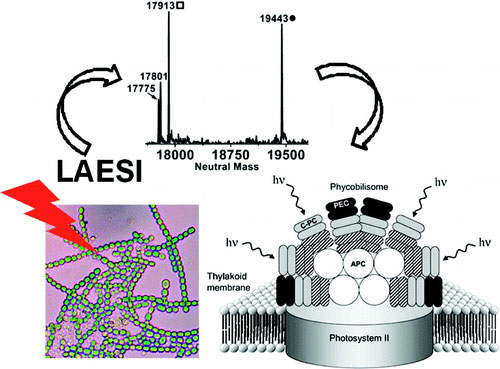B. Shrestha, G. Parsiegla, F. Carrière, A. Vertes
Analytical Chemistry, 2012, 84, 34-38
DOI: 10.1021/ac202831w | Impact factor (2011): 5.874
DOWNNLOAD | ONLINE
SUMMARY
Due to their significance in energy and environmental and natural product research, as well as their large genetic diversity, rapid in situ analysis of cyanobacteria is of increasing interest. Metabolic profiles and the composition of energy harvesting antenna protein complexes are needed to understand how environmental factors affect the functioning of these microorganisms. Here, we show that laser ablation electrospray ionization (LAESI) mass spectrometry enables the direct analysis of phycobilisomal antenna proteins and report on numerous metabolites from intact cyanobacteria. Small populations (n < 616 ± 76) of vegetative Anabaena sp. PCC7120 cyanobacterial cells are analyzed by LAESI mass spectrometry. The spectra reveal the ratio of phycocyanin (C-PC) and allophycocyanin (APC) in the antenna complex, the subunit composition of the phycobiliproteins, and the tentative identity of over 30 metabolites and lipids. Metabolites are tentatively identified by accurate mass measurements, isotope distribution patterns, and literature searches. The rapid simultaneous analysis of abundant proteins and diverse metabolites enables the evaluation of the environmental response and metabolic adaptation of cyanobacteria and other microorganisms.
